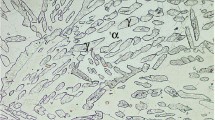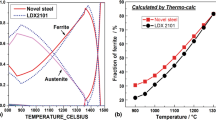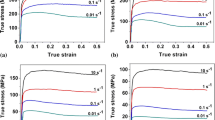Abstract
The hot deformation behavior of 2304 lean duplex stainless steel was investigated by means of processing maps and physically based constitutive modeling in the temperature range of 850 °C to 1050 °C and strain rate of 0.1 to 15 s−1. For all the processing maps developed for strains of 0.1 to 0.6, dynamic restoration mechanisms were efficient in preventing flow instability at low strain rates (1 to 4 s−1) in the studied temperature range. Hot deformation at medium strain rates of 5 to 7 s−1 results in the risk of flow instability. However, for typical industrial purposes, there is a possibility of hot working at higher strain rates (10 s−1 and above) at lower temperatures without the risk of instability by promoting dynamic recrystallization in the austenitic phase of the steel. The flow behavior of the steel can be accurately modeled by coupling the Estring-Mecking constitutive equation (for the work hardening and recovery region) with the Avrami model, which captures the dynamic recrystallization region.







Similar content being viewed by others
References
A.I. Filho, J.M.D.A. Rollo, R. Silva, and G. Martinez: Mater. Lett., 2005, vol. 59, pp. 1192–94. https://doi.org/10.1016/j.matlet.2004.12.026.
J.M. Cabrera, A. Mateo, L. Llanes, J.M. Prado, and M. Anglada: J. Mater. Process Technol., 2003, vol. 143–144, pp. 321–25. https://doi.org/10.1016/S0924-0136(03)00434-5.
R. Badji, M. Bouabdallah, B. Bacroin, C. Kahloun, B. Belkessa, and H. Maza: Mater. Charact., 2008, vol. 59, pp. 447–53. https://doi.org/10.1016/j.matchar.2007.03.004.
P. Cizek, B.P. Wynne, and W.M. Rainforth: J. Micros., 2006, vol. 222, pp. 85–96. https://doi.org/10.1111/j.1365-2818.2006.01576.x.
P. Mao, K. Yang, and G. Su: Mater. Sci. Technol., 2003, vol. 19, pp. 379–83. https://doi.org/10.1179/026708302225004793.
P. Cizek: Acta Mater., 2016, vol. 106, pp. 129–43. https://doi.org/10.1016/j.actamat.2016.01.012.
C.M. Garzon and A.P. Tschiptschin: Mater. Sci. Eng. A., 2006, vol. 441, pp. 230–38. https://doi.org/10.1016/j.msea.2006.08.018.
P. Mao, K. Yang, and G. Su: J. Mater. Sci. Technol., 2003, vol. 19, pp. 379–81.
J.J. Jonas, X. Quelennec, L. Jiang, and E. Martin: Acta Mater., 2009, vol. 57, pp. 2748–56. https://doi.org/10.1016/j.actamat.2009.02.033.
A. Momeni, K. Dehghani, and G.R. Ebrahimi: J. Alloys Compd., 2011, vol. 509, pp. 9387–93. https://doi.org/10.1016/j.jallcom.2011.07.014.
A. Momeni, K. Dehghani, and M.C. Poletti: Mater. Chem. Phys., 2013, vol. 139, pp. 747–55. https://doi.org/10.1016/j.matchemphys.2013.02.026.
A. Quadfasel, J.A. Nietsch, M. Teller, and G. Hirt: Metal., 2021, vol. 11, pp. 1–19. https://doi.org/10.3390/met11081285.
O. Balancin, W.A.M. Hoffman, and J.J. Jonas: Metall. Mater. Trans. A., 2001, vol. 31A, pp. 1353–64. https://doi.org/10.1007/s11661-000-0254-4.
A. Momeni and K. Dehghani: Mater. Sci. Eng. A., 2011, vol. 528, pp. 1448–54. https://doi.org/10.1016/j.msea.2010.11.020.
A.B. Li, L.J. Huang, Q.Y. Meng, L. Geng, and X.P. Cui: Mater. Des., 2009, vol. 30, pp. 1625–31. https://doi.org/10.1016/j.matdes.2008.07.031.
Y.V.R.K. Prasad and T. Sesharyulu: Mater. Sci. Eng. A., 1998, vol. 243, pp. 832–88. https://doi.org/10.1016/S0921-5093(97)00782-X.
S.V.S. Narayana Murty, W.S. Sarma, and B. Nageswara Rao: Metall. Mater. Trans. A., 1997, vol. 28A, pp. 1581–82. https://doi.org/10.1007/s11661-997-0219-y.
Y.V.R.K. Prasad, K.P. Rao, and S. Sasidhara: Hot Working Guide: A Compendium of Processing Maps, 2nd ed. ASM International, Ohio, 2015.
S.V.S. Narayana Murty, B. Nageswara Rao, and B.P. Kashyap: Mater. Sci. Technol., 2004, vol. 20, pp. 772–82. https://doi.org/10.1179/026708304225016671.
A. Laasraoui and J.J. Jonas: Metall. Trans. A., 1991, vol. 22, pp. 1545–57. https://doi.org/10.1007/BF02667368.
Y. Estrin and H. Mecking: Acta Metall. A., 1984, vol. 32, pp. 57–70. https://doi.org/10.1016/0001-6160(84)90202-5.
Q. Guo-Zhang: In Tech., 2013, https://doi.org/10.5772/54285.
S.B. Davenport, N.J. Silk, C.N. Sparks, and C.M. Sellars: Mater. Sci. Technol., 2000, vol. 16, pp. 539–46. https://doi.org/10.1179/026708300101508045.
R.W. Evans and P.J. Scharning: Mater. Sci. Technol., 2001, vol. 17, pp. 995–1004. https://doi.org/10.1179/026708301101510843.
Y.V.R.K. Prasad and K.P. Rao: Mater. Sci. Eng. A., 2005, vol. 31, pp. 141–50. https://doi.org/10.1016/j.msea.2004.08.049.
Y. Han, D. Zou, Z. Chen, G. Fan, and W. Zhang: Mater. Charact., 2011, vol. 62, pp. 198–203. https://doi.org/10.1016/j.matchar.2010.11.013.
N. Haghdadi, D. Martin, and P. Hodgson: Mater. Des., 2016, vol. 106, pp. 420–27. https://doi.org/10.1016/j.matdes.2016.05.118.
Acknowledgments
The authors acknowledge Mintek for financial support through the DSI FMDN program, Columbus Stainless for the supply of materials and technical support and University of Pretoria for the use of the laboratories and equipment.
Author information
Authors and Affiliations
Corresponding author
Ethics declarations
Conflict of interest
The authors declare that they have no conflict of interest.
Research data for this article
The research data for this article are available on the University of Pretoria Bahr Dilatometer machine and the SEM post-processing machine, available on request.
Additional information
Publisher's Note
Springer Nature remains neutral with regard to jurisdictional claims in published maps and institutional affiliations.
Appendices
Appendix 1: Derivation of the W.H. relations
According to the modified representation of the Estrin-Mecking model:
Integrating equation results in the equation for the flow stress in the WH + DRV regime according to the Estrin-Mecking modification given by:
where
The constants in the above equation can be determined from the plot of product of the work hardening rate and stress, θσ, against the square of the stress, σ2. From this plot A is the y-intercept and B the slope of the linear approximation of the plot (Figure A1).
Appendix 2: Derivation of the constants in the Avrami softening model
where the fractional softening
Thus, the values of the constants r and q will be obtained from the plot of ln(−ln(1−X)) against ln(ε−εp) where ln r is the y-intercept and q the slope of the linear approximation of the corresponding plot. From the graph below ln r = 2.1875 and hence r = 8.9 and q = 1.7 (Figure A2).
Rights and permissions
About this article
Cite this article
Bill, O., Siyasiya, C. & Moema, J. Using the Physically Based Constitutive Model and Processing Maps to Understand the Hot Deformation Behavior of 2304 Lean Duplex Stainless Steel. Metall Mater Trans A 53, 1267–1275 (2022). https://doi.org/10.1007/s11661-021-06587-w
Received:
Accepted:
Published:
Issue Date:
DOI: https://doi.org/10.1007/s11661-021-06587-w






